I have been a Studebaker fan for some time. I blame my parents. Back in 1996, during a particularly difficult year health-wise, my mom and dad took me to an SDC meet at the Moline Holiday Inn. I was smitten. There were so many cool models! 1950-51 “bullet nose” Champions and Commanders, Golden Hawks, Larks, all kinds of great stuff. But perhaps my favorite model at the show was the Gran Turismo Hawk.
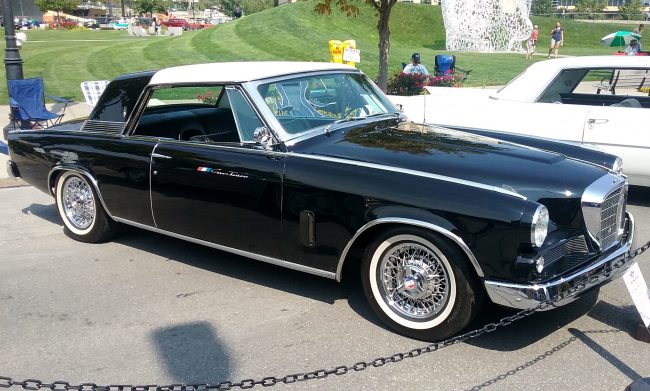
1964 Gran Turismo Hawk at the 2017 Des Moines Concours d’Elegance
Cleverly restyled by Milwaukee-based industrial designer, Brooks Stevens, this was essentially a 1953 “Loewy coupe” with some cosmetic surgery and a Thunderbird-inspired roofline. Introduced for the 1962 model year, it was a surprisingly modern update for such an old design. Keep in mind, most American cars in the ’50s and ’60s got 2-3 year redesigns, even if it was sitting atop the same old chassis. Studebaker, with the lack of the Big Three’s deep pockets, had to improvise.
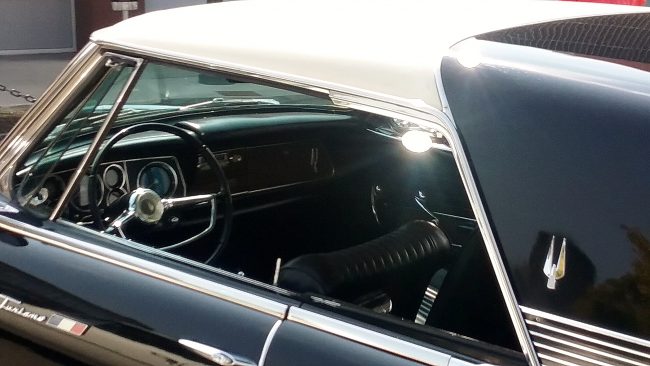
I don’t recall which of the 4-6 GT Hawks really reeled me in, but I loved the design. I especially loved that instrument cluster filled with gauges, curved to make them all easily viewable by the owner. Said owner most likely wearing driving gloves and smoking a pipe…
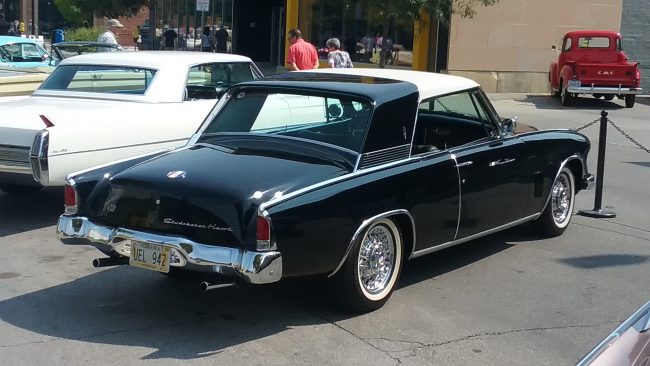
At any rate, the summer of 1996 was the year I really started loving Studebakers, and those Gran Turismo Hawks were a big factor. Later on I got the most excellent Crestline Studebaker book (sadly out of print now). I spent hours looking through it, seeing all the changes between the Conestoga wagon and carriage years to the Classic era and on to streamlined postwar models.

Studebaker’s a heartbreaker. So many amazing cars, but at the same time so many dumb decisions made. For better or worse, Studebaker was about half-past irrelevancy by the 1958 recession, and only the compact Lark’s success bought them a few more years. The Avanti, a cleverly disguised Lark made into an ultra-modern grand tourer, never really sold.
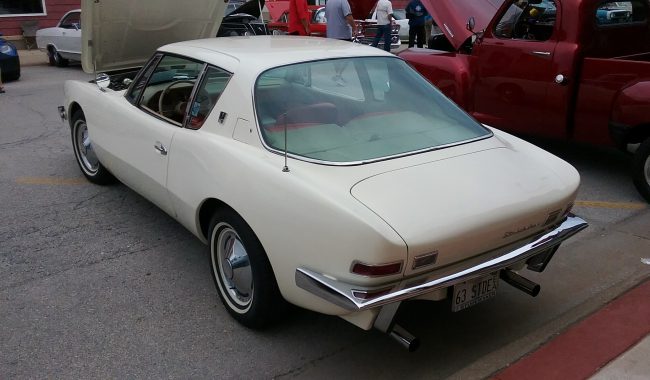
Initial teething problems due to the fiberglass body didn’t help. And even when the car was finally sorted and readily available, many folks demurred. Studebaker appeared to be on the ropes, and despite the appeal, most buyers decided not to gamble.
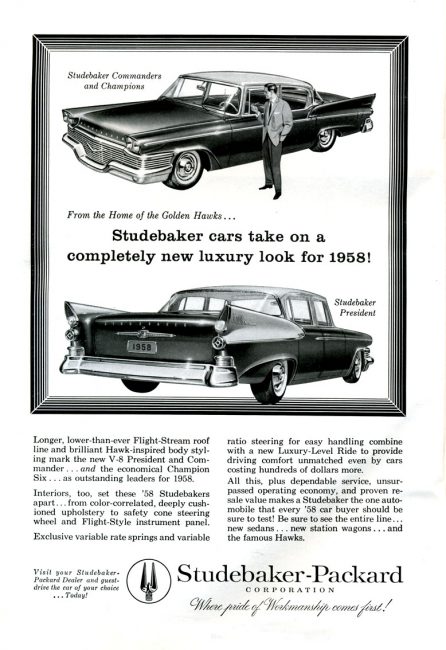
But throughout the final years of Studebaker’s existence, the breadwinner was the Lark. In fact, if not for the Lark, Studebaker cars might have petered out in 1958, which was a horrible year for the company. In a nutshell, the Lark was a 1958 Studebaker Champion with the nose and tail cut down to shorten it into a “compact.”
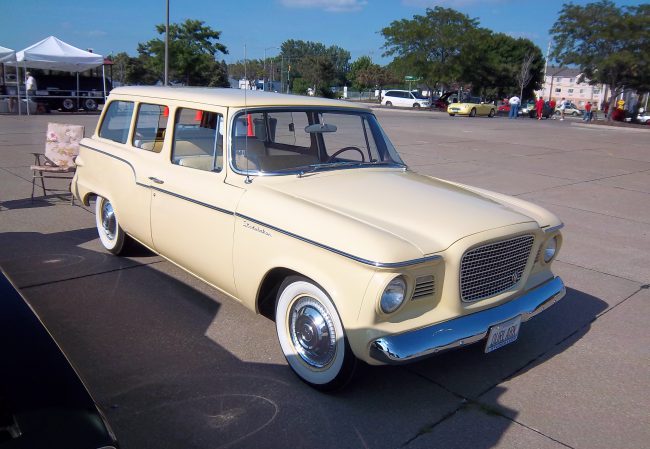
Thanks to the unaltered center section, interior room was very good. The Lark first appeared in 1959, and brought some much needed cash to Studebaker’s coffers. It also bought the car division some time.
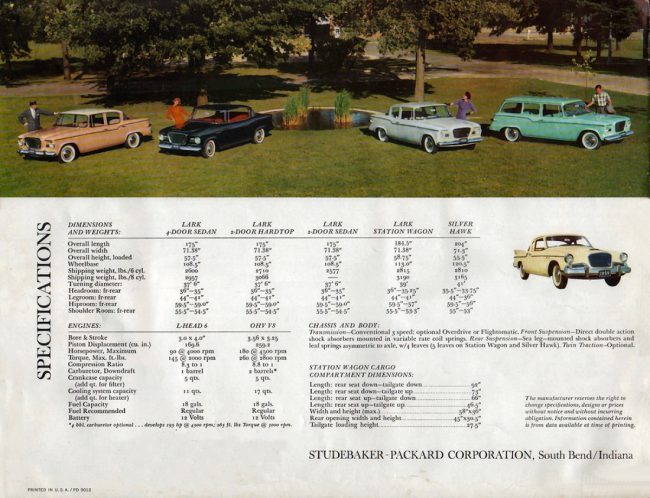
In 1959, primary competition for the Lark was Rambler, VW, and Renault. Yes, Renault. The tiny four-door Dauphine took sold over 100,000 that year, a huge increase. Unfortunately for Renault the cars had the durability of sugar cubes in the rain, and in the long run, it disappeared. So the Lark was in a pretty good spot.
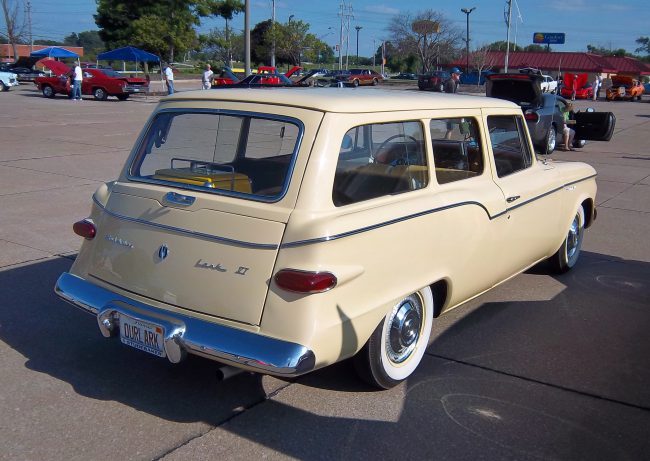
But it didn’t last. The very next year, Ford, GM and Chrysler released their own compacts, and although sales for Lark in ’60 weren’t bad, it was down. And it would keep going down.
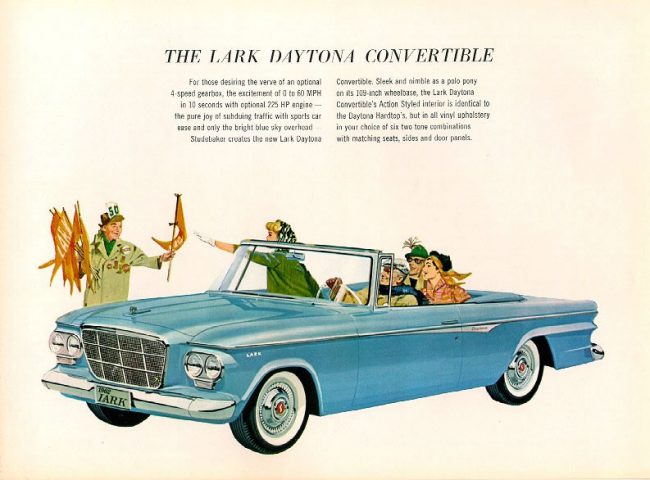
Brooks Stevens redesigned the Lark for ’62, with a decidedly Mercedes-like look. It made sense, as Studebaker-Packard was the official importer for Mercedes-Benz in the U.S. at that time. But it didn’t really help. Despite the redesign, it still looked quite a bit like the original ’59.
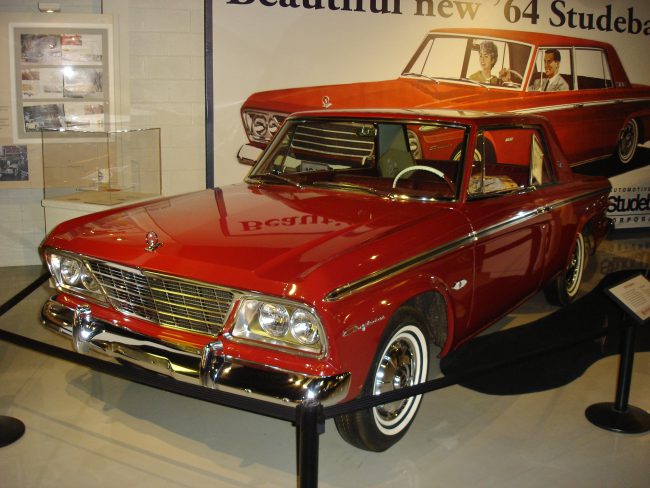
1964 Daytona hardtop at the Studebaker Museum
The last attempt to keep the Lark current came in model year 1964. An attractive facelift, which squared up most of the Fifties-style curves, was done yet again by Brooks Stevens. And on a shoestring. But sales still lagged. It seemed no one was terribly interested in buying a Studebaker any more. And Studebaker wasn’t terribly interested in building them either.
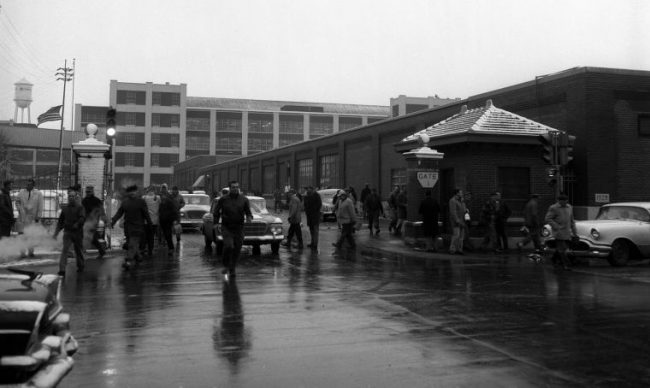
image: southbendtribune.com
Just before Christmas of 1963, the historic, amazing, but ancient and inefficient factory complex in South Bend was shut down. Daytona hardtops and convertibles were axed, as were the aforementioned Avanti and Gran Turismo Hawk.
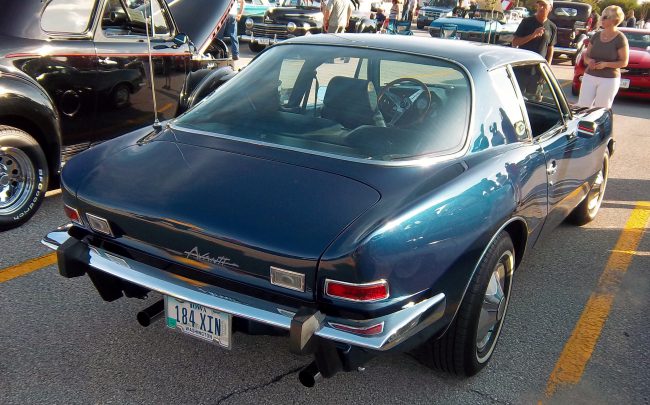
Early ’80s Avanti II
However, the Avanti would get a second life. And so would a part of the South Bend factory, when Nate Altman and Leo Newman, former Studebaker dealers, resumed production of the Avanti-now with a “II” moniker added and Chevrolet 350 V8 power. It’s beyond the Studebaker story, but Avanti IIs lasted well into the late ’80s.

1966 Studebaker Daytona
And so was it that the final Studebakers were technically imports. Shipped from Studebaker’s satellite plant in Canada to U.S. dealers, which were growing increasingly thin by that time. But some diehards stuck it out to the bitter end. Only two-door sedans, four-door sedans and station wagons remained in the lineup, in Daytona, Commander and Cruiser trim levels.
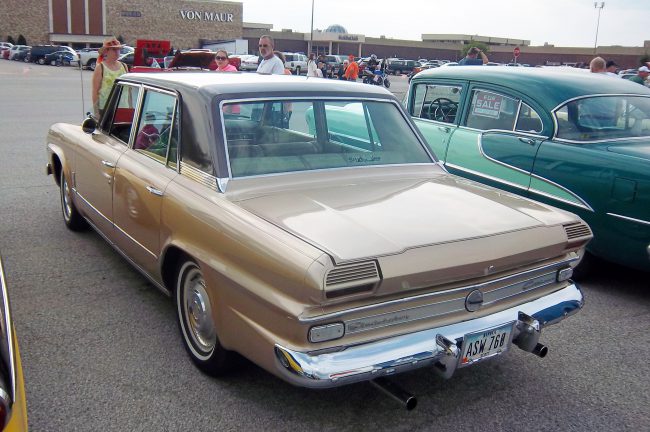
In addition, all 1965-66 Studebakers sported Chevrolet V8s (technically McKinnon, as that was the manufacturer in Canada). The Studebaker engine plant–the final operational part of South Bend after 1963–was shuttered for good after the 1964 model year run was finished.

Yet there was still an effort made for 1966, for the swan-song 1966 Studebakers received a minor yet attractive facelift. And the Cruiser sedan remained top of the line, with a very attractively updated interior.
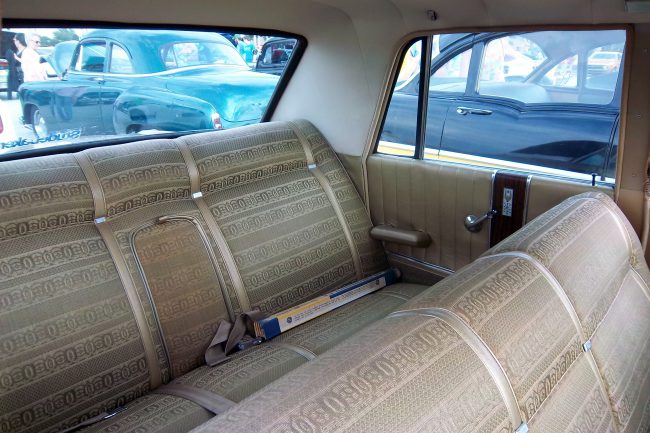
1966 Studebaker seating was far more luxuriously appointed for the year, with upholstery choices being rather Cadillac or Lincoln-like. It makes one wonder what could have happened if Studebaker had held on just a few more years…Lark Broughams, perhaps?
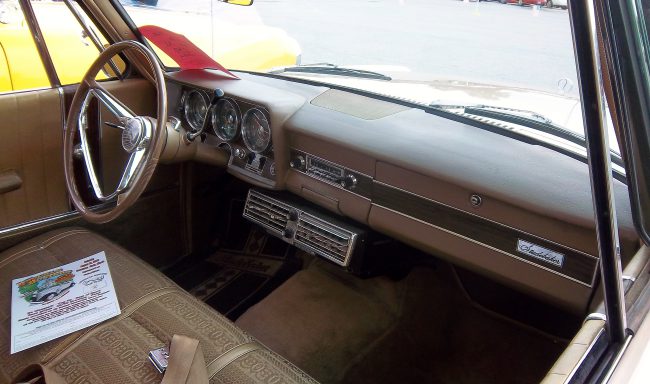
This gold example was the first ’66 Cruiser I’d seen in the metal at the time I took these pictures in the summer of 2013. I was impressed with the junior-Cadillac interior. Just look at those seats! Not bad.
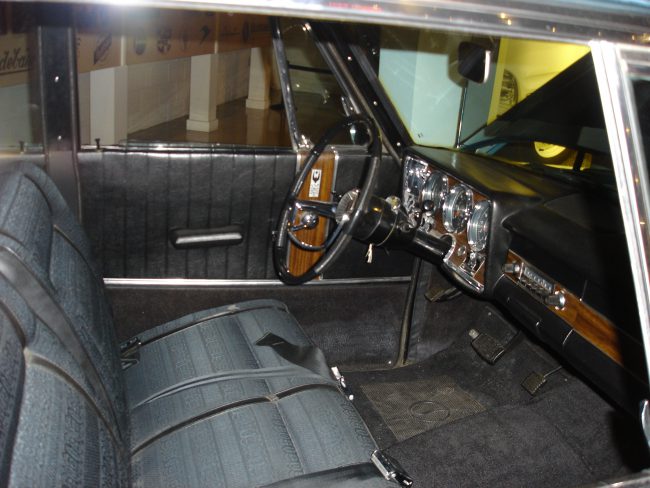
And as previously mentioned, more woodgrain appeared, on both the instrument panel and door panels. The effect was very much that of a luxury car in a miniature scale, though still Studebaker Sensible with wind-up windows, simple armrests and no Automatic Climate Control.
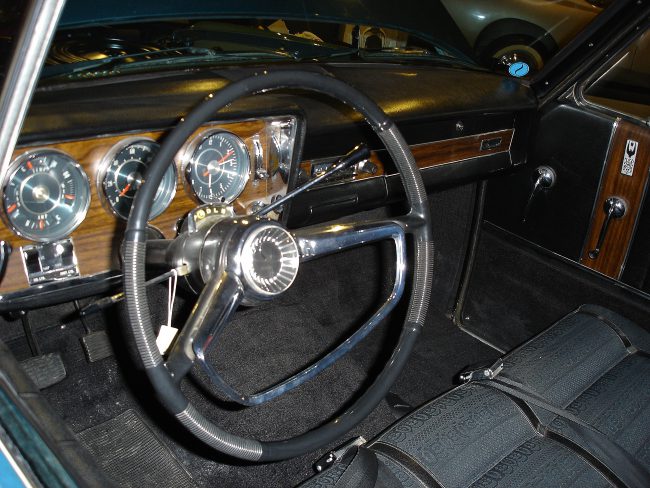
No, no one was going to mistake it for a Fleetwood or Continental. However, it was a nice effort for what was a modestly-priced compact car, sized much like–and priced within a couple hundred dollars of–the contemporary Plymouth Valiant Signet.
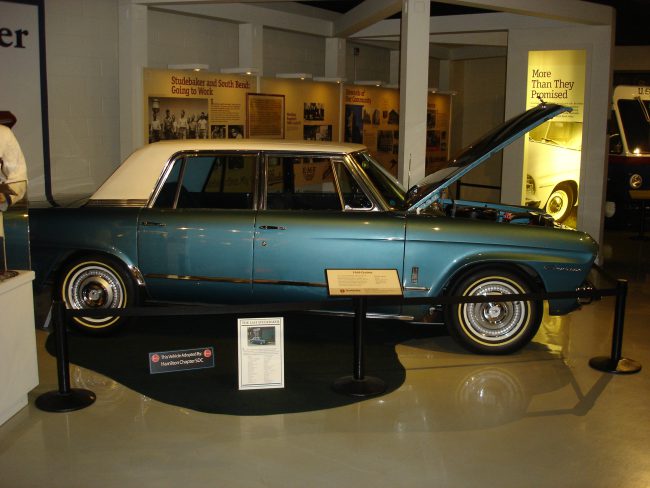
The last Studebaker built, a 1966 Cruiser in Timberline Turquoise.
Fun fact: The very last Studebaker built was also a Cruiser. I took these pictures while visiting the Studebaker National Museum with Jim Cavanaugh in 2015. It was used as a courtesy car for Studebaker executives when new and was donated to the Museum years back. With the black cloth upholstery and attractive metallic aqua paint, it had a rather upscale look for a car of its size.
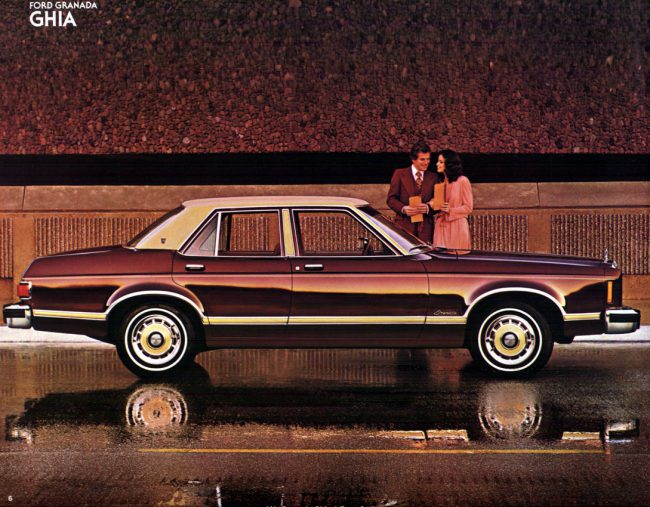
Ten years later Ford would sell a similar package in their Mini-Me Ford Granada Ghias, with air conditioning, power windows and even available leather. They sold like dollar beer at a baseball game. It makes one wonder…coulda, shoulda, woulda.
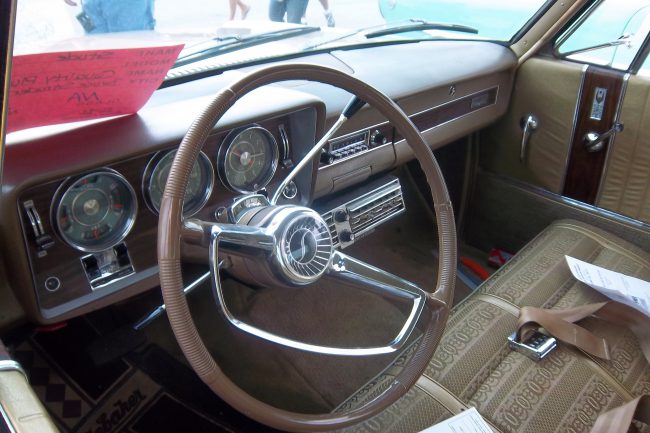
Upholstery aside, 1966 Studebakers would have been very familiar to owners of earlier Larks.he very clean and functional instrument panel introduced for 1963 remained much the same. I love the design, it’s very European. The Cruiser was the second best selling model of the year, but it was a small victory. That only amounted to 2,901 of the top-tier sedans, with a $2,610 base price.

Studebaker’s last champion of the auto division, Sherwood Egbert, had to step down from his position during this time, due to declining health. Shortly after his exit from the company, the remaining corporate drones unanimously decided to kill the car division and focus on STP, Paxton, Gravely Tractors, and other assorted recently-purchased divisions.
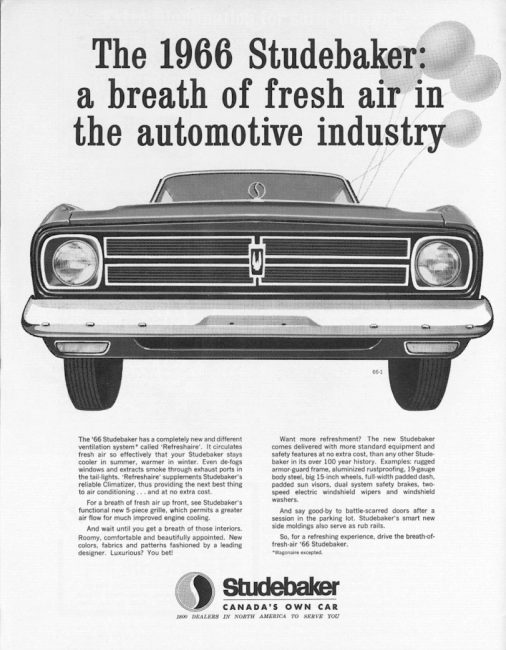
I can see why that happened-the car division had been a loser and giant money drain for years. But who can, even today, be sure whether it was for the best or not? Could things have been turned around? Or would it have been throwing good money after bad? Sure, it would have been great to see Studebaker around a few more years, but it has to pay for itself if it’s to survive. Like all businesses of course. All I can do is shake my head and say, Studebaker, you made some damn cool stuff and I’m glad you were around–at least for a time.
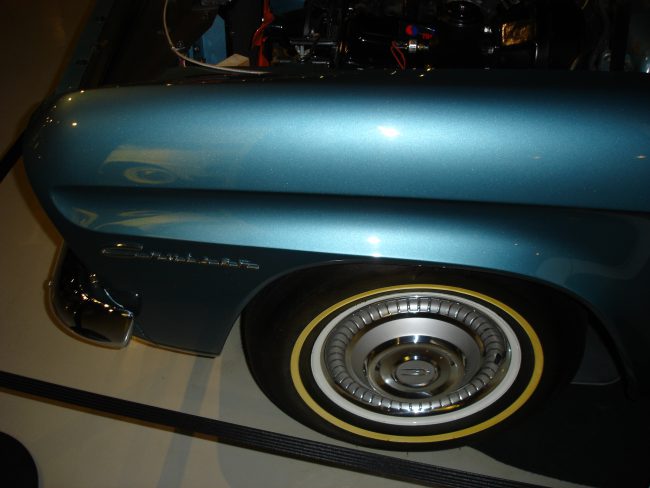


Great pictures and nice summary of the promise and disappointment of Studebaker’s final years. The problem for Studebaker was their South Bend factory was so obsolete, which combined with a non-cooperative UAW workforce meant they had very high manufacturing costs, which are not a good way of making profits on small cars. One reason the Champion could be turned into the compact Lark was because the Champion was so narrow, and it was so narrow because a factory built for making wagons and buggies couldn’t accommodate anything wider. Still it was amazing what they were able to do with so few resources – masterful facelifts, and optional superchargers, disc brakes, fiberglass fascias, sunroofs, before anyone else in Detroit, and the best instrument panels in the industry – the Avanti and Hawk/GTs dashboards still look modern today. But some details in your pictures also show the problems – the flat floor and shallow seats because the frame was the same as from 1952, so not as roomy as unit bodied Ramblers, Corvairs, Falcons, and Valiants. The hung under the dash A/C unit also pointed to the lack of budget for an integrated unit that was becoming standard on GM cars.
SIGH .
I grew up surrounded by Studebakers and their Dealers, watched it all slip away in 1966 .
My favorite was a 1964 Datyona owned by Dick Blake, a WWII Veteran who taught me many good things .
-Nate
As someone who enjoys reading corporate histories, of course Studebaker’s saga drew me in a long time ago. At first it seemed tragic; but the more I read of it, the more it seemed a corporate amputation by a succession of feckless management teams. First, the pre-Packard Studebaker, which would not get its cash losses under control. Then, the fraudulent purchase by Packard – where Studebaker presented cooked books. It was so bad that a year later, Packard’s legal counsel suggested an undoing of the purchase, for the fraudulent reports and jiggered books.
However by that time Packard was in the soup, as the Briggs Body Works, which made Packard carbodies, had been purchased by Chrysler. There was no practical supply or source for bodies; and Packard hadn’t the room to put in a body plant.
James Nance, the pwned head of what was now Studebaker-Packard, somehow figured outside management would be the answer. After all, Packardbakers didn’t do it and Studebaker sales continued their free-fall. So somehow they were gulled into bringing Curtiss-Wright in…although the details are sketchy to me, it sounded like corporate rape and robbery.
Nance and his fecklessness gone, FINALLY S-P was free of the outsiders. The decision was made to try to capitalize on the Compact market Rambler was so-successfully milking. Just cut the front and rear of the Champion down.
First to the market, brought record sales and profits. The decision was, again, made – “diversify” – which was front-office speak for “find other products to take the place of the auto business.” So, instead of new models, S-P went on their legendary buying spree.
In comes the young Marine, Sherwood Egbert. An outsider to the auto industry, and independent and a leader. What I’d read suggested the board hired him to gradually wind down the auto section.
What they didn’t count on was that Egbert became a born-again pistonhead. He was SO taken with the business, and the David-And-Goliath struggle Studebaker faced…he even dreamed up, and then launched, the Avanti.
While the board indulged him, that was not what they hired him for. When stomach cancer took him out, permanently as it turned out…the decision was made. When the UAW contract expires…CLOSE DOWN SOUTH BEND.
…but, WAIT! We have DEALER CONTRACTS. And they’ll sue; and we are NOT bankrupt.
FIne. Make ONE car. Make it only marginally saleable. Price it to match the Chevrolet Impala – which would disqualify the obsolete Studebaker Daytona, right there. Let the dealers have the FULL LINE – you can have two doors or four; or a wagon.
So the dealers did what would be expected. They dropped out; or picked up other car lines, or used cars.
When enough were gone that the risk of a lawsuit blizzard was passed…AND when the Motor Vehicle Safety Act of 1966 was passed…it was time to lock up Hamilton.
There was no way Studebaker was going to meet the new Federal standards. By that time they had NO engineering department; what design there was, was contracted out. Nope, it was inevitable.
FWIW, it was later revealed that Studebaker did NOT lose money on the Canadian operation. They showed a small profit the last few years…they didn’t sell to their official breakeven point, but again, the belief was, that was deliberately pushed higher, out of reach, to justify the planned future closing.
Making a profit on such a small run of non-luxury cars, with so many parts contracted out, was truly remarkable. But the board had little use for Gordon Grundy, the can-do Canadian plant manager who was de-facto GM of the Auto Division.
Nance was an interesting guy, and I think his plan for Packard to create a mid-level Clipper division and push Packard back upmarket might have worked if Studebaker’s cooked books and Briggs sale to Chrysler hadn’t pulled him under. If they merged with anyone, they should have merged with Hudson, which was literally just down the street in Detroit and already had a body plant and solid middle class reputation to complement the high end Packard. But after getting beat up trying to save Packard, he jumped over to Ford to take over the Edsel division – talk about jumping out of the pan and into the fire.
JPT, you about sum up what I understand about Studebaker-Packard. This happened during the time that all the MBA-led corporations believe in diversifying far beyond the core competencies. This would come back to bite them in the ass in later years, but for a while it worked. Too bad it took out historical companies like Studebaker and eventually Oldsmobile, too.
Like you, I believe that Studebaker could have made a run for it utilizing the Canadian operations, with enough financial help they could have survived the upcoming US regulations, but clearly the board was not interested. I guess STP and lawn tractors were a better use of stockholder’s funds.
There were some Studebaker genes in my family as well. My mother had a 1950 Champion coupe that she loved, and my sister in law had a ’49 Champion. Before my time, my father had a handsome ’41 Commander coupe, fat whitewalls and all, that he drove through World War II.
Dad loved to go showroom hopping, and the showroom we frequently wound up in was David R. McGeorge Car Company, the Stude dealer for Richmond. I like the perky little Larks and was impressed by the Avanti, but the knockout for me was the ’62 GT Hawk. Dad liked it enough to take one for a test drive – it was black with red upholstery. My mother hoped he would go for it, but apparently Dad could see Studebaker’s fate and turned it down. The interiors on those ’66 Cruisers are beautiful.
I ended up with a 1963 Studebaker Champ through a rental property fiasco. No title, so still trying to get that straightened out.
One of the very last 63’s made, 64 was the last year, not many of them made that year. Original 259 V8, should still start and run. Bed is gone of course.
Not sure what the final plan is. Depends on how much it’s going to cost me to get a bonded title in WI. The wiring is screwed, but I’ve been down that road before.
The Champ was basically a Lark body on a truck frame.
Vintage pickups are hot on the collector market now – and the Champ was a neat little truck.
Actually the Champ only used the front sheet metal from the Lark. That’s why it looks a bit “awkward” at the cowl.
Wasn’t the “fleetside” box something purchased from Dodge, so the lines didn’t line up at all with the cab?
You sir, get to pick a prize from the top shelf.
Great write up. There are volumes written to cover all the gory details about Studebaker’s downfall, but either way it wasn’t pretty.
A couple of minor corrections on the Avant II; originally they had 327 Chevy engines, and they were made, off and on, into 2006.
http://www.classic-car-history.com/avanti-car-history.htm
You’re right on both counts, but after Avanti dumped the original body circa 1990, I don’t quite consider them Avantis any more. I remember seeing the Camaro/Firebird based ones at the Chicago Auto Show in about 2001.
Yes, the later ones bore faint resemblance to the original. The 4 door and convertible versions, while interesting, were a bit too much for most (myself included).
The last re-design of the body really brought it up to modern styling trends for the 1965-1967 era, it could have made it all the way to 1969-1970 if they had wanted to keep selling Studebakers. AMC still sold the Rambler American through 1969, as did the last of the square Falcons.
I like the ad pitching the Daytona coupe as a junior “musclecar”.
For a “what could have been” look up the never made Avanti inspired Lark prototypes, I think there are 3 of them left, they look really awkward.
In hindsight, Studebaker would have probably been better of not making the Avanti and coming up with a cheaper Mustang style car from the Lark, it wouldn’t have saved them probably nothing would have saved Studebaker by 1963, but it probably could have bought them more time.
Carmine, I saw those prototypes at the Stude Museum when I visited it with Jim Cavanaugh in ’15. They were pretty cool. They could have taken Studebaker into at least the early ’70s. I frequently wonder how Studebakers would have looked in the early ’70s if they had survived. Sometimes I think they’d be similar to Mavericks and Pintos, cheap and cheerful, and by the mid-70s turning into mini-Broughams like the Granada Ghia/Monarch and Volare’ Premiers. Who knows?
How would they have made it past the imposition of Federal Standards in 1968?
First, that steering column. If you look at it carefully, without the chrome horn ring…that’s EXACTLY the same steering column Kaiser Jeep was using in SJ vehicles, and later AMC used in AM General Postal Jeeps.
As well as Kaiser M715s. It was a generic TRUCK steering column – and didn’t have a telescoping component, as the new standards demanded for passenger cars.
Smog. Canadian Studebaker bought their engines from a GM subsidiary in Canada; first, I don’t know who else used those engines. Were they mostly marine engines? Crate engines? Probably they were never fitted with smog…controls on non-automotive engines came much later. In any event, as AMC learned, the government made pooling resources on emissions controls, forbidden. Even though AMC shared a few engines with GM, they had to do their own emissions work. I remember a Popular Mechanics interview with the Chrysler head of emissions complance; and he was quite bitter and outspoken.
Belts. The seat belts, no problem. Shoulder harnesses, added a whole ‘nuther layer of engineering. It was a bit more complex than just bolting a bet anchor to a roof support.
Although I think closing down the car line was always Studebaker-Worthington’s plans, the Federal Standards made it inevitable. The ONLY potential way around it was to merge with a stronger partner, and Studebaker was instead envisioning a future of STP and Gravely and ALCO locomotives.
Tom, another great article.
Those Gran Turismos are just so sweet and the heartache of the last Larks and Daytonas just kills me. If I had the billions necessary…
“It makes one wonder…coulda, shoulda, woulda”
That sums up Studepackard well. If they joined the AMC alliance we might have seen something special.
As a side note. Am I the only one that sees the Avanti design as half baked? I do and I’m not sorry.